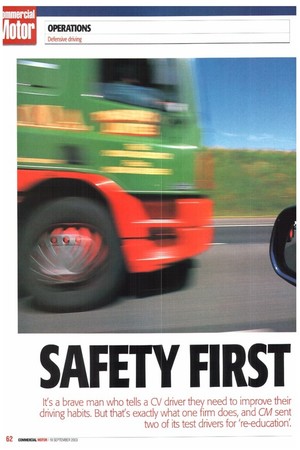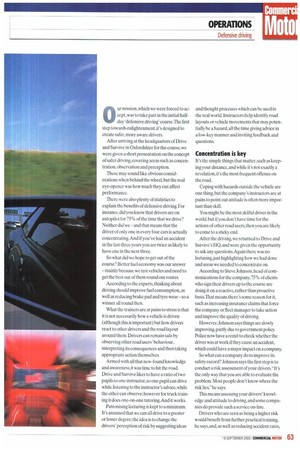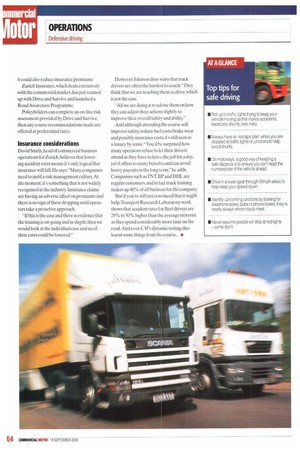SAFETY F FIST
Page 62

Page 63

Page 64

If you've noticed an error in this article please click here to report it so we can fix it.
It's a brave man who tells a CV driver they need to improve their
driving habits. But that's exactly what one firm does, and CM sent two of its test drivers for 're-education'.
Our mission, which we were forced to accept, was to take part in the initial halfday 'defensive driving' course.The first step towards enlightenment, it's designed to create safer, more aware drivers.
After arriving at the headquarters of Drive and Survive in Oxfordshire for the course, we were given a short presentation on the concept of safer driving, covering areas such as concentration. observation and perception.
These may sound like obvious considerations when behind the wheel, but the real eye-opener was how much they can affect performance.
There were also plenty of statistics to explain the benefits of defensive driving. For instance, did you know that drivers are on autopilot for 75% of the time that we drive? Neither did we — and that means that the driver of only one in every four cars is actually concentrating. And if you've had an accident in the last three years you are twice as likely to have one in the next three.
So what did we hope to get out of the course? Better fuel economy was our answer —mainly because we test vehicles and need to get the best out of them round our routes.
According to the experts, thinking about driving should improve fuel consumption, as well as reducing brake pad and tyre wear—so a winner all round then.
What the trainers are at pains to stress is that it is not necessarily how a vehicle is driven (although this is important) but how drivers react to other drivers and the road layout around them. Drivers can remain safe by observing other road users' behaviour, interpreting its consequences and then taking appropriate action themselves.
Armed with all that new-found knowledge and awareness, it was time to hit the road. Drive and Survive likes to have a ratio of two pupils to one instructor, so one pupil can drive while listening to the instructor's advice, while the other can obsenie;however for truck training it does one-on-one tutoring. And it works.
Patronising lecturing is kept to a minimum. It's assumed that we can all drive to a greater or lesser degree; the idea is to change the drivers' perception of risk by suggesting ideas and thought processes which can be used in the real world. Instructors help identify road layouts or vehicle movements that may potentially be a hazard, all the time giving advice in a low-key manner and inviting feedback and questions.
Concentration is key
It's the simple things that matter, such as keeping your distance, and while it's not exactly a revelation, it's the most frequent offence on the road.
Coping with hazards outside the vehicle are one thing, but the company's instructors are at pains to point out attitude is often more important than skill.
You might be the most skilful driver in the world, but if you don't have time for the actions of other road users, then you are likely to come to a sticky end.
After the driving, we returned to Drive and Survive's HQ, and were given the opportunity to ask any questions.Again there was no lecturing, just highlighting how we had done and areas we needed to concentrate on.
According to Steve Johnson, head of communications for the company, 75% of clients who sign their drivers up to the course are doing it on a reactive, rather than proactive basis.That means there's some reason for it, such as increasing insurance claims that force the company or fleet manager to take action and improve the quality of driving.
However, Johnson says things are slowly improving, partly due to government policy. Police now have a remit to check whether the driver was at work if they cause an accident, which could have a major impact on a company.
So what can a company do to improve its safety record? Johnson says the first step is to conduct a risk assessment of your drivers."It's the only way that you are able to evaluate the problem. Most people don't know where the risk lies," he says.
This means assessing your drivers' knowledge and attitude to driving, and some companies do provide such a service on-line.
Drivers who are seen as being a higher risk would benefit from further practical training, he says, and, as well as reducing accident rates, it could also reduce insurance premiums.
Zurich Insurance, which deals extensively with the commercial market, has just teamed up with Drive and Survive and launched a Road Awareness Programme.
Policyholders can complete an on-line risk assessment provided by Drive and Survive, then any course recommendations made are offered at preferential rates.
Insurance considerations David Smith, head of commercial business operations for Zurich, believes that lowering accident rates means it's only logical that insurance will fall, He says: "Many companies need to instil a risk management culture.At the moment, it's something that is not widely recognised in the industry. Insurance claims are having an adverse affect on premiums and there is no sign of these dropping until operators take a proactive approach.
"If this is the case and there is evidence that the training is on-going and in-depth, then we would look at the individual case and see if their rates could be lowered." However Johnson does warn that truck drivers are often the hardest to coachr"They think that we are teaching them to drive, which is not the case.
"All we are doing is to advise them on how they can adjust their actions slightly to improve their overall safety and ability."
And although attending the course will improve safety, reduce fuel costs, brake wear and possibly insurance costs, it's still seen as a luxury by some. "You'd be surprised how many operators refuse to let their drivers attend as they have to leave the job for a day, yet it offers so many benefits and can avoid heavy payouts in the long term," he adds. Companies such as TNT. B P and DHL are regular customers, and in fact truck training makes up 40% of all business for the company.
But if you're still not convinced that it might help,Transport Research Laboratory work shows that accident rates for fleet drivers are 29% to 50% higher than the average motorist as they spend considerably more time on the road.And even CM's dynamic testing duo learnt some things from the course... •




























































































































































































